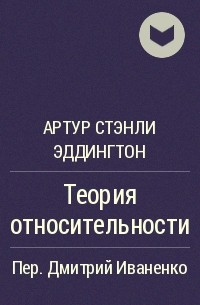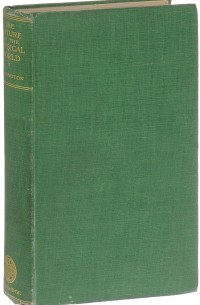
Автор
Артур Стэнли Эддингтон - все книги по циклам и сериям | Книги по порядку
- 10 произведений
- 3 издания на 3 языках
-
Относительность и кванты Артур Стэнли Эддингтон
ISBN: 978-5-9710-9006-9 Год издания: 2021 Издательство: URSS Язык: Русский В книге выдающегося английского ученого, профессора Кембриджского университета Артура Эддингтона (1882–1944) представлены избранные места из его лекций, излагающие физическое содержание теории относительности и квантовой теории. Блестящая манера изложения, соединенная с большой изобретательностью в примерах, делает книгу ценным пособием для первоначального ознакомления с этими непростыми для понимания разделами современной физики.
Книга будет интересна как для широкого круга читателей, так и для специалистов – математиков и физиков, философов и историков науки. -
New Pathways In Science Артур Стэнли ЭддингтонThis vintage book contains a fascinating book on scientific theory and development, written by sir Arthur Eddington. It contains a discussion of the philosophical outlook of modern science, a summary of then-contemporary knowledge, and a number of fascinating and insightful lectures on the various scientific topics. The chapters of this book include: 'Science and Experience', 'Dramatis Personae', 'The End of the World', 'The Decline of Determinism', 'Indeterminacy and Quantum Theory', 'Probability', 'The Constitution of the Stars', 'Subatomic Energy', 'Cosmic Clouds and Nebulae', and more. We are republishing this vintage text now in an affordable, modern edition – complete with a specially commissioned new biography of the author.
-
The Changing Conceptions of the Universe - From Newton to Einstein - Артур Стэнли ЭддингтонEinstein's contributions to our ideas of time and space and to our knowledge of the universe in general, are of so momentous a nature, that they easily take their place among the two or three greatest achievements of the twentieth century. This book attempts to give, in popular form, an account of this work. As, however, Einstein's work is so largely dependent upon the work of Newton and Newton's successors, the first two chapters are devoted to the latter.
-
The Nature of the Physical World Артур Стэнли Эддингтон"The Nature of the Physical World" by Arthur Stanley Eddington. Published by Good Press. Good Press publishes a wide range of titles that encompasses every genre. From well-known classics & literary fiction and non-fiction to forgotten−or yet undiscovered gems−of world literature, we issue the books that need to be read. Each Good Press edition has been meticulously edited and formatted to boost readability for all e-readers and devices. Our goal is to produce eBooks that are user-friendly and accessible to everyone in a high-quality digital format.
-
The Nature of the Physical World Артур Стэнли Эддингтон
Год издания: 1928 Издательство: Cambridge University Press Язык: Русский Cambridge University Press, Лондон, 1928 год.
Издательский переплет, сохранность хорошая.
Потертости по краям обложки, на форзаце штамп книжного магазина, титульный лист имеет сквозную потертость, в тексте присутствуют владельческие подчеркивания и надписи простым карандашом.
The course of Gifford Lectures that Eddington delivered in the University of Edinburgh in January to March 1927. It treats of the philosophical outcome of the great changes of scientific thought which have recently come about. The theory of relativity and the quantum theory have led to strange new conceptions of the physical world; the progress of the principles of thermodynamics has wrought more gradual but no less profound change. The first eleven chapters are for the most part occupied with the new physical theories, with the reasons which have led to their adoption, and especially with the conceptions which seem to underlie them. The aim is to make clear the scientific view of the world as it stands at the present day, and, where it is incomplete, to judge the direction in which modern ideas appear to be tending. In the last four chapters I consider the position which this scientific view should occupy in relation to the wider aspects of human experience, including religion.







